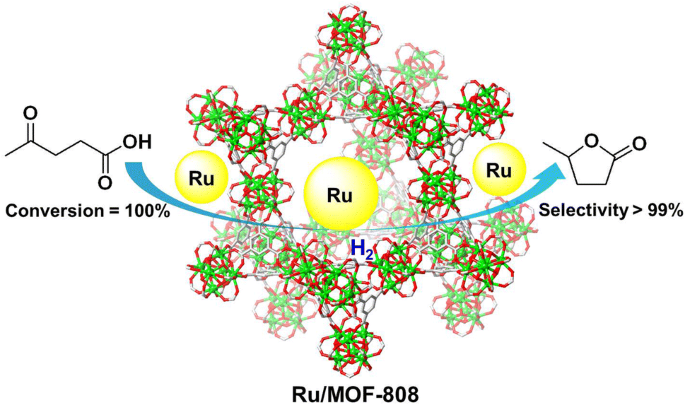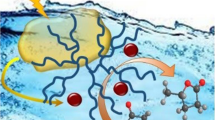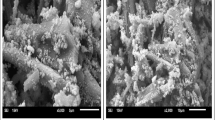Abstract
A stable Zr-based metal–organic framework (MOF), MOF-808, was used as a promising support to immobilize metallic Ru for the first time. The skeleton structure of MOF-808 can be well preserved during the immobilization process. Ru nanoparticles existed both inside and outside of the MOF cavities with good dispersion. The developed Ru/MOF-808 composite was found to be an efficient catalyst for the hydrogenation of biomass-derived levulinic acid (LA) to γ-valerolactone (GVL). Under mild reaction conditions, full conversion of LA (100%) with high selectivity to GVL (> 99%) was achieved. The catalyst recycling and hot filtration experiments indicate that Ru/MOF-808 possesses a good catalytic stability for the LA hydrogenation reaction, although some catalyst structure changes were observed. The good immobilization effect of MOF-808 for Ru may be related to the high binding affinity between the Zr6 nodes and Ru particles.
Graphic Abstract












Similar content being viewed by others
References
Yang D, Odoh SO, Wang TC, Farha OK, Hupp JT, Cramer CJ, Gagliardi L, Gates BC (2015) Metal−organic framework nodes as nearly ideal supports for molecular catalysts: NU-1000- and UiO-66-supported iridium complexes. J Am Chem Soc 137:7391–7396
Moon HR, Lim D-W, Suh MP (2013) Fabrication of metal nanoparticles in metal–organic frameworks. Chem Soc Rev 42:1807–1824
Yang Q, Xu Q, Jiang H-L (2017) Metal–organic frameworks meet metal nanoparticles: synergistic effect for enhanced catalysis. Chem Soc Rev 46:4774–4808
Jiao L, Wang Y, Jiang H-L, Xu Q (2017) Metal–organic frameworks as platforms for catalytic applications. Adv Mater 29:1703663
Huang Y-B, Liang J, Wang X-S, Cao R (2017) Multifunctional metal–organic framework catalysts: synergistic catalysis and tandem reactions. Chem Soc Rev 46:126–157
Li G, Zhao S, Zhang Y, Tang Z (2018) Metal–organic frameworks encapsulating active nanoparticles as emerging composites for catalysis: recent progress and perspectives. Adv Mater 30:1800702
Bai Y, Dou Y, Xie L-H, Rutledge W, Li J-R, Zhou H-C (2016) Zr-based metal–organic frameworks: design, synthesis, structure, and applications. Chem Soc Rev 45:2327–2367
Feng J, Li M, Meng X (2019) Green oxidation of cyclohexanone to adipic acid over phosphotungstic acid encapsulated in UiO-66. Catal Lett 149:1504–1512
Cavka JH, Jakobsen S, Olsbye U, Guillou N, Lamberti C, Bordiga S, Lillerud KP (2008) A new zirconium inorganic building brick forming metal organic frameworks with exceptional stability. J Am Chem Soc 130:13850–13851
Furukawa H, Gándara F, Zhang Y-B, Jiang J, Queen WL, Hudson MR, Yaghi OM (2014) Water adsorption in porous metal−organic frameworks and related materials. J Am Chem Soc 136:4369–4381
Zheng H-Q, Liu C-Y, Zeng X-Y, Chen J, Lü J, Lin R-G, Cao R, Lin Z-J, Su J-W (2018) MOF-808: a metal−organic framework with intrinsic peroxidase-like catalytic activity at neutral pH for colorimetric biosensing. Inorg Chem 57:9096–9104
Wang T, Gao L, Hou J, Herou SJA, Griffiths JT, Li W, Dong J, Gao S, Titirici M-M, Kumar RV, Cheetham AK, Bao X, Fu Q, Smoukov SK (2019) Rational approach to guest confinement inside MOF cavities for low-temperature catalysis. Nat Commun 10:1340
Baek J, Rungtaweevoranit B, Pei X, Park M, Fakra SC, Liu Y-S, Matheu R, Alshmimri SA, Alshehri S, Trickett CA, Somorjai GA, Yaghi OM (2018) Bioinspired metal−organic framework catalysts for selective methane oxidation to methanol. J Am Chem Soc 140:18208–18216
Feng J, Zhang Y, Xiong W, Ding H, He B (2016) Hydrogenolysis of glycerol to 1,2-propanediol and ethylene glycol over Ru-Co/ZrO2 catalysts. Catalysts 6:51
Feng J, Xiong W, Xu B, Jiang W, Wang J, Chen H (2014) Basic oxide-supported Ru catalysts for liquid phase glycerol hydrogenolysis in an additive-free system. Catal Commun 46:98–102
Tang X, Zeng X, Li Z, Hu L, Sun Y, Liu S, Lei T, Lin L (2014) Production of γ-valerolactone from lignocellulosic biomass for sustainable fuels and chemicals supply. Renew Sustain Energy Rev 40:608–620
Yan K, Yang Y, Chai J, Lu Y (2015) Catalytic reactions of gamma-valerolactone: a platform to fuels and value-added chemicals. Appl Catal B 179:292–304
Dutta S, Yu IKM, Tsang DCW, Ng YH, Ok YS, Sherwood J, Clark JH (2019) Green synthesis of gamma-valerolactone (GVL) through hydrogenation of biomass-derived levulinic acid using non-noble metal catalysts: a critical review. Chem Eng J 372:992–1006
Piskun AS, Ftouni J, Tang Z, Weckhuysen BM, Bruijnincx PCA, Heeres HJ (2018) Hydrogenation of levulinic acid to γ-valerolactone over anatase-supported Ru catalysts: effect of catalyst synthesis protocols on activity. Appl Catal A 549:197–206
Filiz BC, Gnanakumar ES, Martínez-Arias A, Gengler R, Rudolf P, Rothenberg G, Shiju NR (2017) Highly selective hydrogenation of levulinic acid to γ-valerolactone over Ru/ZrO2 catalysts. Catal Lett 147:1744–1753
Tan J, Cui J, Ding G, Deng T, Zhu Y, Li Y-W (2016) Efficient aqueous hydrogenation of levulinic acid to γ-valerolactone over a highly active and stable ruthenium catalyst. Catal Sci Technol 6:1469–1475
Ftouni J, Genuino HC, Munoz-Murillo A, Bruijnincx PCA, Weckhuysen BM (2017) Influence of sulfuric acid on the performance of ruthenium-based catalysts in the liquid-phase hydrogenation of levulinic acid to γ-valerolactone. Chemsuschem 10:2891–2896
Li S, Wang Y, Yang Y, Chen B, Tai J, Liu H, Han B (2019) Conversion of levulinic acid to γ-valerolactone over ultra-thin TiO2 nanosheets decorated with ultrasmall Ru nanoparticle catalysts under mild conditions. Green Chem 21:770–774
Abdelrahman OA, Heyden A, Bond JQ (2014) Analysis of kinetics and reaction pathways in the aqueous-phase hydrogenation of levulinic acid to form γ-valerolactone over Ru/C. ACS Catal 4:1171–1181
Xiao C, Goh T-W, Qi Z, Goes S, Brashler K, Perez C, Huang W (2016) Conversion of levulinic acid to γ-valerolactone over few-layer graphene-supported ruthenium catalysts. ACS Catal 6:593–599
Wei Z, Lou J, Su C, Guo D, Liu Y, Deng S (2017) An efficient and reusable embedded Ru catalyst for the hydrogenolysis of levulinic acid to γ-valerolactone. Chemsuschem 10:1720–1732
Yang Y, Sun C-J, Brown DE, Zhang L, Yang F, Zhao H, Wang Y, Ma X, Zhang X, Ren Y (2016) A smart strategy to fabricate Ru nanoparticle inserted porous carbon nanofibers as highly efficient levulinic acid hydrogenation catalysts. Green Chem 18:3558–3566
Wei Z, Li X, Deng J, Wang J, Li H, Wang Y (2018) Improved catalytic activity and stability for hydrogenation of levulinic acid by Ru/N-doped hierarchically porous carbon. Mol Catal 448:100–107
Yao Y, Wang Z, Zhao S, Wang D, Wu Z, Zhang M (2014) A stable and effective Ru/polyethersulfone catalyst for levulinic acidhydrogenation to γ-valerolactone in aqueous solution. Catal Today 234:245–250
Cao W, Luo W, Ge H, Su Y, Wang A, Zhang T (2017) UiO-66 derived Ru/ZrO2@C as a highly stable catalyst for hydrogenation of levulinic acid to γ-valerolactone. Green Chem 19:2201–2211
Guo Y, Li Y, Chen J, Chen L (2016) Hydrogenation of levulinic acid into γ-valerolactone over ruthenium catalysts supported on metal–organic frameworks in aqueous medium. Catal Lett 146:2041–2052
Zhang X, Zhang P, Chen C, Zhang J, Yang G, Zheng L, Zhang J, Han B (2019) Fabrication of 2D metal–organic framework nanosheets with tailorable thickness using bio-based surfactants and their application in catalysis. Green Chem 21:54–58
Valekar AH, Cho K-H, Chitale SK, Hong D-Y, Cha G-Y, Lee U-H, Hwang DW, Serre C, Chang JS, Hwang YK (2016) Catalytic transfer hydrogenation of ethyl levulinate to γ-valerolactone over zirconium-based metal–organic frameworks. Green Chem 18:4542–4552
Lin Z, Cai X, Fu Y, Zhu W, Zhang F (2017) Cascade catalytic hydrogenation–cyclization of methyl levulinate to form γ-valerolactone over Ru nanoparticles supported on a sulfonic acid-functionalized UiO-66 catalyst. RSC Adv 7:44082–44088
Molleti J, Tiwari MS, Yadav GD (2018) Novel synthesis of Ru/OMS catalyst by solvent-free method: selective hydrogenation of levulinic acid to γ-valerolactone in aqueous medium and kinetic modeling. Chem Eng J 334:2488–2499
Yan Z-P, Lin L, Liu S (2009) Synthesis of γ-valerolactone by hydrogenation of biomass-derived levulinic acid over Ru/C catalyst. Energy Fuels 23:3853–3858
Lin S, Zhao Y, Bediako JK, Cho C-W, Sarkar AK, Lim C-R, Yun Y-S (2019) Structure-controlled recovery of palladium(II) from acidic aqueous solution using metal–organic frameworks of MOF-802, UiO-66 and MOF-808. Chem Eng J 362:280–286
Acknowledgements
This work was supported by the National Natural Science Foundation of China (51708075, 51604052), the Natural Science Foundation of Chongqing (cstc2019jcyj-msxmX0401), and the Open Fund of Chongqing Key Laboratory of Industrial Fermentation Microorganism, Chongqing University of Science and Technology (LIFM201708).
Author information
Authors and Affiliations
Corresponding authors
Ethics declarations
Conflict of interest
The authors declare no conflict of interest.
Additional information
Publisher's Note
Springer Nature remains neutral with regard to jurisdictional claims in published maps and institutional affiliations.
Electronic supplementary material
Below is the link to the electronic supplementary material.
Rights and permissions
About this article
Cite this article
Feng, J., Zhong, Y., Xie, M. et al. Using MOF-808 as a Promising Support to Immobilize Ru for Selective Hydrogenation of Levulinic Acid to γ-Valerolactone. Catal Lett 151, 86–94 (2021). https://doi.org/10.1007/s10562-020-03277-x
Received:
Accepted:
Published:
Issue Date:
DOI: https://doi.org/10.1007/s10562-020-03277-x




